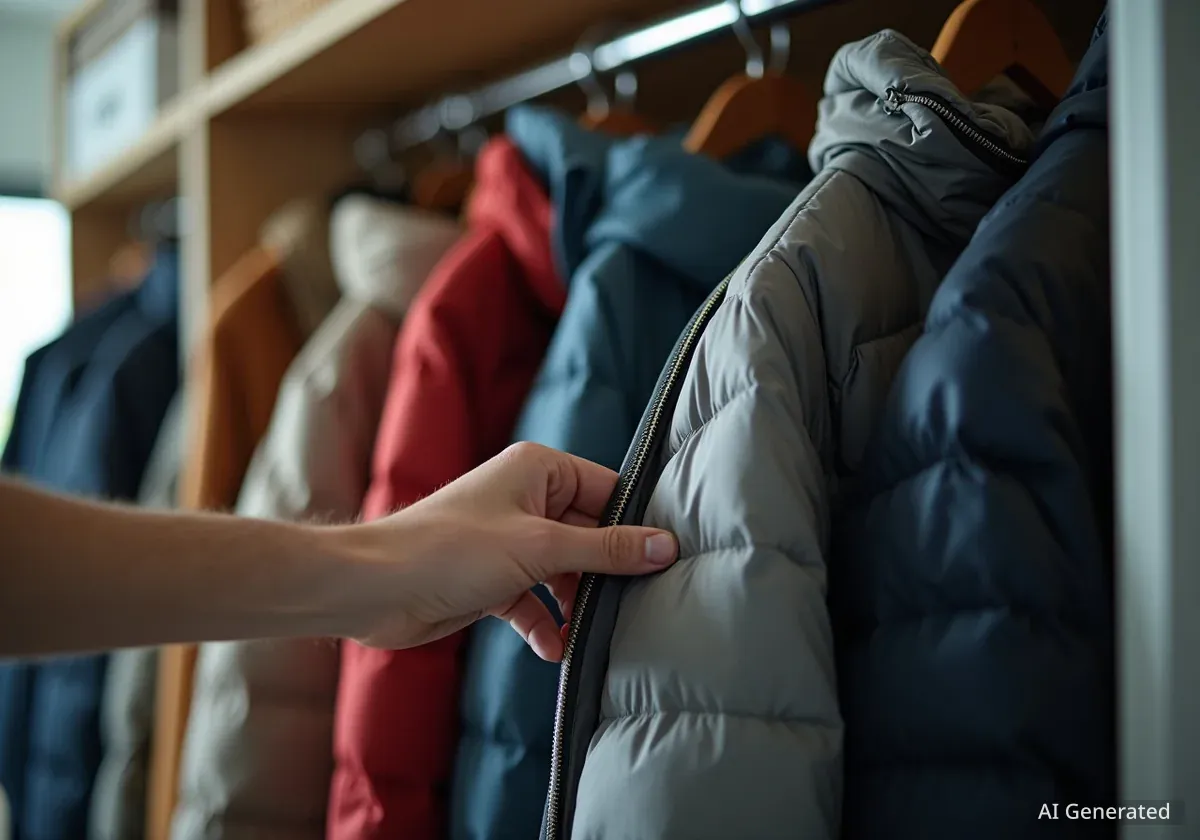Modern athletic jackets are designed to offer a blend of warmth, weather resistance, and comfort without the bulk of traditional outerwear. A key innovation driving this trend is the use of advanced 3-layer fabric construction, which combines distinct materials to create a single, high-performance textile suitable for a wide range of activities and conditions.
Understanding the technology behind these garments can help consumers make more informed decisions when selecting outerwear for activities ranging from daily commuting to mountain hiking. The materials and construction methods directly impact a jacket's performance in wind, rain, and cold temperatures.
Key Takeaways
- Modern athletic jackets frequently use a 3-layer fabric system to combine weather protection, insulation, and durability in a lightweight design.
- The fabric composition typically includes a durable outer layer (often polyester/spandex), a central weather-resistant membrane (like TPU), and a soft inner fleece lining for warmth.
- The primary function of the middle membrane is to block wind and resist water while allowing internal moisture vapor to escape, a property known as breathability.
- This versatile construction allows the jacket to function as a standalone piece in mild conditions or as part of a layering system in colder weather.
The Core Components of 3-Layer Fabric
The effectiveness of modern athletic outerwear often comes down to its multi-layer fabric. Instead of a single material trying to perform all functions, these textiles laminate three specialized layers together. Each layer has a specific job, and their combination creates a versatile and efficient final product.
The Outer Woven Layer for Durability
The outermost layer is the garment's first line of defense against the elements and physical wear. It is typically made from a synthetic woven fabric, such as a blend of polyester and spandex. Polyester provides significant durability and resistance to abrasion, which is crucial for outdoor activities like hiking or cycling where the jacket might brush against surfaces.
The inclusion of a small percentage of spandex, usually around 5%, introduces flexibility and stretch. This allows the jacket to move with the body, providing a greater range of motion without feeling restrictive. This is particularly important for athletic pursuits that involve dynamic movement.
The Central Membrane for Weather Protection
Sandwiched between the outer and inner layers is the technical core of the fabric: a thin membrane. In many mid-range athletic jackets, this is a Thermoplastic Polyurethane (TPU) membrane. This layer is engineered to be both water-resistant and windproof.
Its microscopic pores are small enough to prevent liquid water droplets from passing through, which keeps the wearer dry in light rain or snow. However, these pores are large enough to allow smaller water vapor molecules (sweat) to escape from the inside. This one-way moisture transfer is what defines breathability, a critical feature for preventing overheating and dampness during physical exertion.
What is a TPU Membrane?
Thermoplastic Polyurethane (TPU) is a versatile polymer known for its elasticity, transparency, and resistance to oil, grease, and abrasion. In textiles, it's used as a waterproof yet breathable film that can be bonded to other fabrics. It provides weather protection without the stiffness of older waterproofing materials.
The Inner Fleece Lining for Insulation
The layer closest to the body is designed for comfort and warmth. A fleece lining is a popular choice for this purpose. Fleece is a soft, synthetic fabric known for its excellent insulating properties. It traps air between its fibers, creating a thermal barrier that holds in body heat.
Unlike natural materials like cotton, fleece is also hydrophobic, meaning it does not absorb much moisture. It helps wick sweat away from the skin and move it toward the outer layers, keeping the wearer dry and comfortable. This combination of warmth and moisture management makes fleece an ideal insulating layer for active use.
Performance and Practical Applications
The combination of these three layers results in a jacket that can adapt to various weather conditions and activity levels. The design aims to strike a balance between protection from the elements and comfort during physical activity.
Water-Resistant vs. Waterproof
It is important to distinguish between "water-resistant" and "waterproof." Water-resistant fabrics, like those with a TPU membrane, can handle light rain and snow for a limited time. Fully waterproof garments often have sealed seams and more robust membranes (like Gore-Tex) designed to withstand heavy, sustained downpours, but this can sometimes come at the cost of reduced breathability and higher price points.
Versatility Across Seasons and Activities
One of the main advantages of this type of construction is its versatility. The jacket is substantial enough to serve as a primary outer layer during the transitional seasons of spring and fall. The fleece lining provides adequate warmth for cool temperatures, while the outer shell protects against wind and light showers.
In colder winter conditions, the jacket can function as an effective midlayer. Worn under a heavier, fully waterproof shell, it provides a crucial layer of insulation. This layering system is highly effective because it allows the wearer to add or remove garments to regulate their body temperature as conditions or activity levels change.
"The goal of modern outerwear is to reduce the number of items you need. A well-designed softshell or insulated jacket can replace a separate windbreaker and a fleece, offering both functions in one streamlined piece." - Excerpt from an outdoor gear industry report.
Designed for an Active Lifestyle
The properties of 3-layer fabric make it suitable for a wide array of activities. The balance of breathability and insulation is ideal for pursuits where body temperature fluctuates.
- Hiking and Mountaineering: The jacket provides warmth during rest periods and breathes during strenuous climbs. Its durability stands up to rough terrain.
- Cycling and Running: Windproof properties are essential for these activities, as they prevent wind chill. The fabric's stretch allows for unrestricted movement.
- Daily Commuting and Travel: The lightweight design and casual aesthetic make it a practical choice for everyday wear, easily transitioning from an outdoor setting to an indoor one.
The machine-washable nature of the polyester and fleece materials also adds to its practicality for regular use. By combining these features, manufacturers aim to create a single garment that meets the needs of a diverse consumer base looking for performance, comfort, and value.





